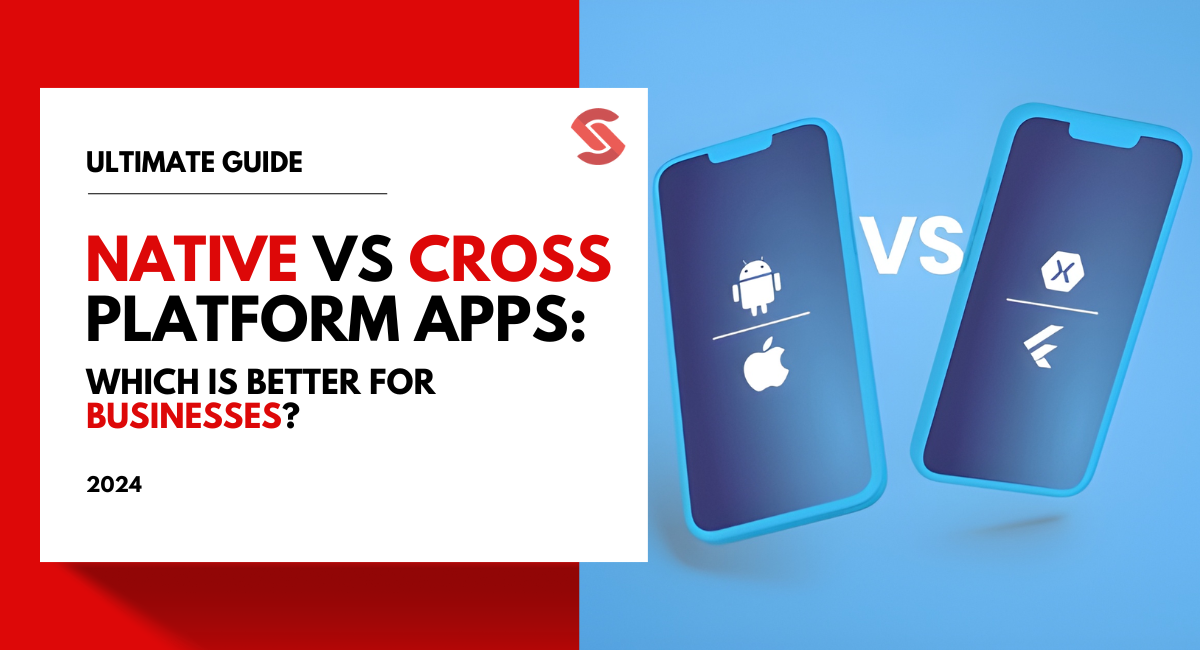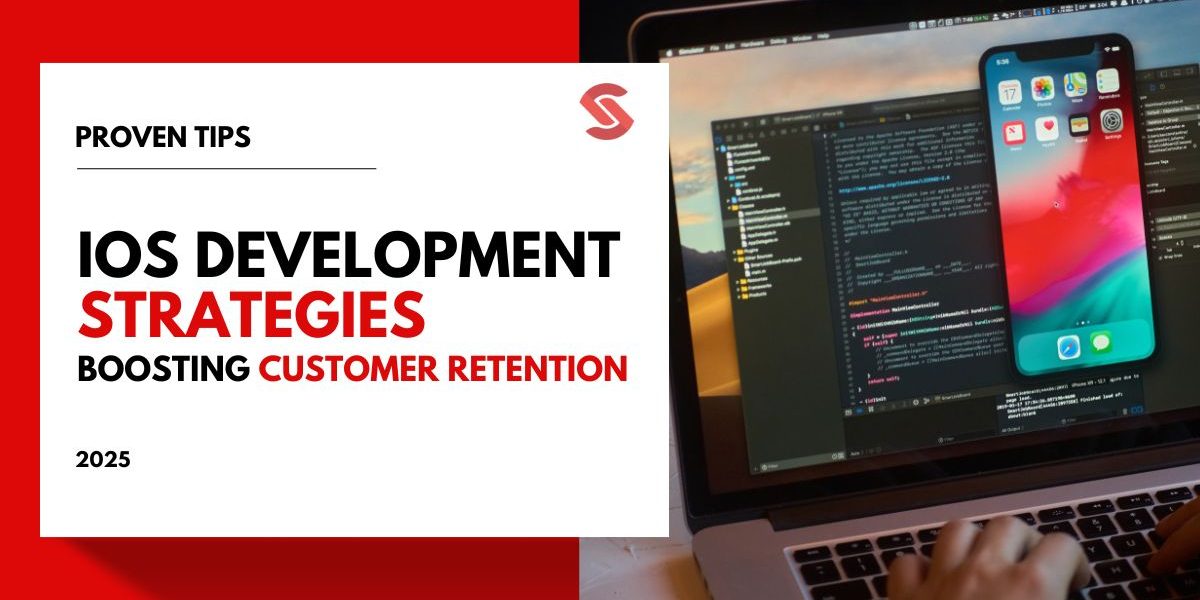Two decades ago, it was unimaginable that we’d order food or play games with a simple touch of a button on our phones. But today, it’s a reality! Mobile apps have become a necessity for our daily lives, fundamentally changing the way we work, play, and communicate.
The mobile app development industry has grown immensely since 2007 and according to Statista, the global mobile app market is projected to reach $756 billion by 2027. Now, we have a plethora of tools and technologies at our disposal. Among these, native and cross-platform app development have emerged as the leading approaches for building mobile applications.
If you are planning to develop a mobile app and want to understand the differences between native and cross-platform approaches, this blog is for you. We’ll explore the pros and cons of each method in detail to help you make the right choice for your business.
What is Native App Development?
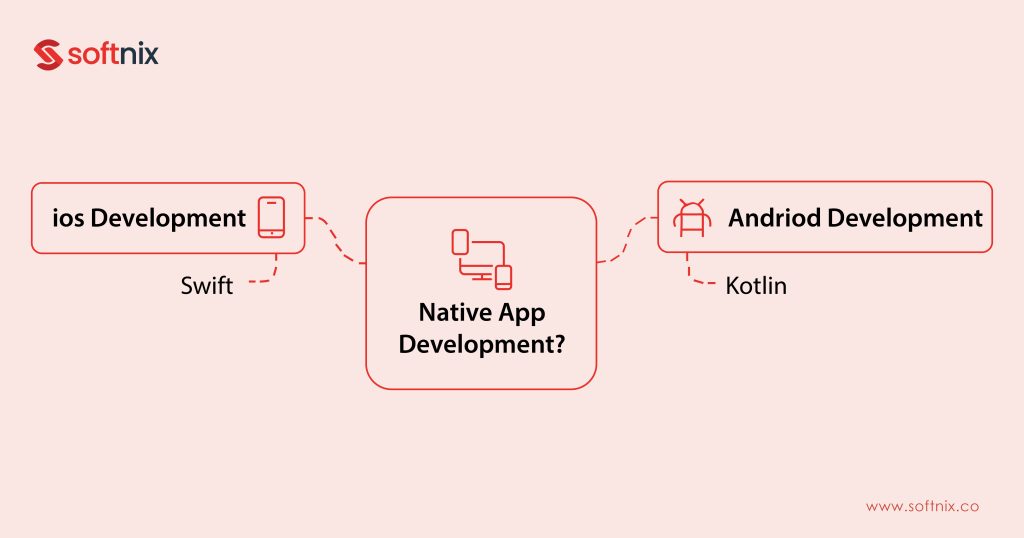
In simple terms, native apps are developed to work exclusively on a particular operating system, such as iOS (for Apple devices) or Android (for most other smartphones and tablets). This means that native apps are tailored to take full advantage of the unique features and capabilities of each platform.
To create native apps, developers use programming languages specific to each platform:
- Swift: This is the main language for iOS app development. It boasts modern syntax, enhanced safety features, and excellent performance. It is an upgrade from Objective-C, making iOS app development more streamlined and efficient.
- Kotlin: This is the popular language for Android app development. It’s fully compatible with Java, which makes it a great choice for both new projects and the enhancement of existing Android applications.
These languages allow developers to leverage the specific features and APIs (Application Programming Interfaces) provided by each platform, ensuring that the apps can utilize the latest hardware and software advancements.
If you’re curious about how native app development might evolve in the future, you can explore the future of mobile app development and explore emerging technologies and innovations.
Why Choose Native App Development for Your Business (Pros)?
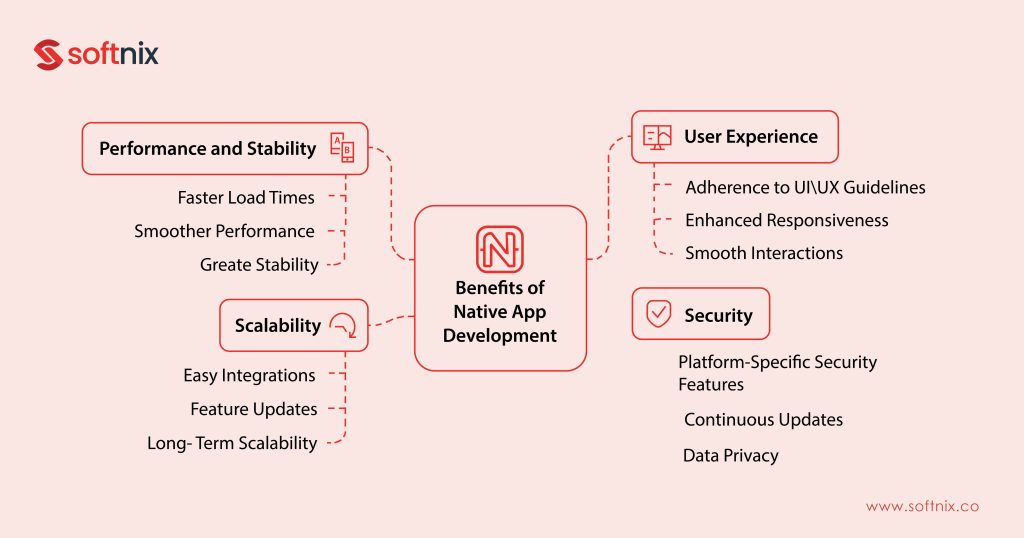
Native app development is often considered the gold standard for businesses that want high-quality, high-performance applications. Unlike cross-platform apps, native apps are built specifically for one operating system, allowing them to use all the features and tools unique to that platform.
Companies like Facebook, Todoist, Trello, and Fortnite have opted for native apps because of their numerous advantages.
1. Better Performance and Stability
Native applications are developed specifically for a particular operating system, which allows them to take advantage of platform-specific features, software, and hardware. This specialization results in faster load times, smoother performance, and greater stability.
Performance is a critical factor when users decide whether they want to keep using an app. Apps like gaming or video streaming apps, which require high performance, often benefit most from native development, as it minimizes resource consumption and provides a seamless user experience.
Find how to ensure your app’s long-term stability, by building scalable and secure mobile apps.
2. Excellent User Experience
Native apps offer an unmatched user experience by aligning perfectly with each platform’s UI/UX guidelines. The result is an intuitive, aesthetically pleasing, and highly responsive app that feels like an inherent part of the device.
The direct access to APIs and hardware means that native apps offer a level of responsiveness and interaction that cross-platform apps often struggle to match. For example, gaming apps built natively can leverage the device’s GPU to provide smoother animations, leading to a better gaming experience.
Following platform-specific guidelines also ensures a consistent experience, which encourages higher user engagement and satisfaction.
Softnix’s Native App Solutions
3. Enhanced App Security
Security is another area where native apps shine. By being developed specifically for a particular operating system, native apps benefit from all the built-in security features of the OS. These features, which include encryption and advanced authentication, are continually updated to address critical threats.
For businesses dealing with sensitive user data, such as financial services or healthcare, this added layer of security is crucial. Native apps offer a more secure environment, ensuring that data is handled safely and effectively, thus minimizing the risk of data breaches.
4. Increased Scalability
Native development makes it easy to scale applications for upcoming features or integrations. Since native apps are built using robust frameworks that are already designed for extensibility, the development team can efficiently incorporate new functionalities or updates as required.
For companies with long-term visions of growth, native app development provides greater flexibility for scaling. As your app becomes more complex, native development is better equipped to handle increased user loads and maintain a smooth user experience.
Disadvantages of Native App Development
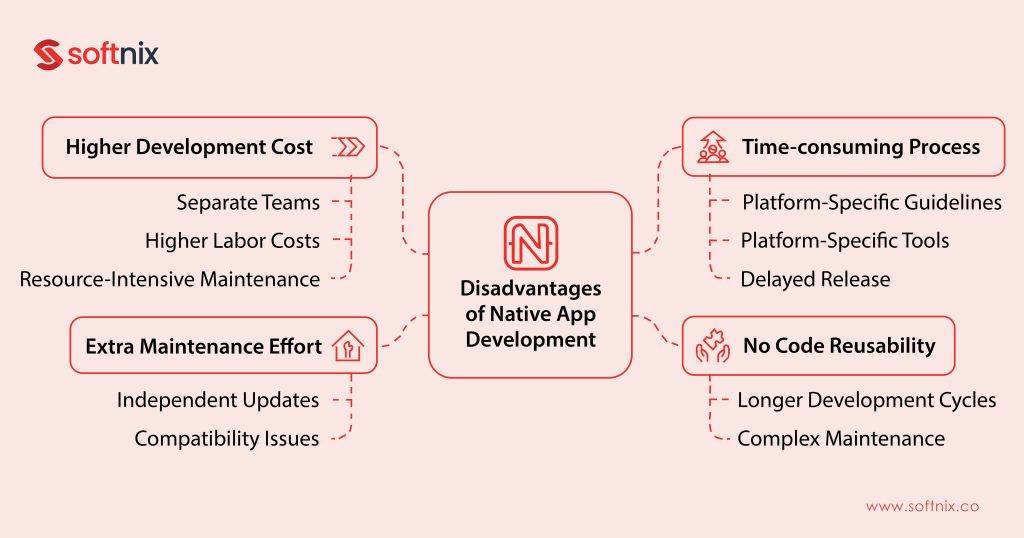
While native apps bring a lot to the table, they also have some drawbacks, especially for smaller businesses that might be operating on a limited budget.
1. Higher Development Costs
Native app development typically involves building separate versions of an app for iOS and Android. This means hiring developers experienced in each platform, which increases both development and maintenance costs.
Maintaining two separate codebases can be resource-intensive compared to working with a single codebase, as in cross-platform development. While native apps offer superior optimization, these initial costs might be prohibitive for small businesses or startups.
2. Time-Consuming Process
Developing native apps can be time-consuming, as businesses have to create separate apps for each platform and work with platform-specific guidelines, tools, and languages. Additionally, developers need to test and debug each app individually, which takes more time compared to cross-platform approaches.
For companies with tight deadlines or those looking to quickly launch a minimum viable product (MVP), the longer development cycle may be a challenge. Nevertheless, the quality and stability of native apps often justify this extra effort.
If you’re interested to know the full breakdown of how long it takes to make an app.
3. No Code Reusability
Unlike cross-platform development, where developers can reuse code for both iOS and Android, native app development requires entirely separate codebases for each platform. This can lead to longer development cycles and increased maintenance efforts, which might be inefficient for simpler apps with fewer platform-specific requirements.
4. Extra Maintenance Effort
Maintaining native apps is more effort-intensive compared to cross-platform apps. Each app must be updated independently to ensure compatibility with the latest OS versions, features, and patches.
Businesses with smaller development teams may find it challenging to maintain two separate codebases effectively.
Tools and Technologies for Native App Development

Here are some tools and frameworks that make native app development easier:
| Technology | Function | Used For | Best For |
| Swift | Programming language for iOS/macOS | Creating native iOS/macOS apps | Businesses targeting Apple |
| Kotlin | Programming language for Android | Creating native Android apps | Businesses targeting Android |
| Xcode | IDE for macOS | Developing iOS, macOS, watchOS, and tvOS | Apple developers |
| Android Studio | IDE for Windows, macOS, and Linux | Developing Android apps | Android developers |
| Cocoa Touch | Framework for building UI and apps | Native apps for iOS, macOS, watchOS, etc. | Apple developers |
| Android SDK | Software development kit for Android | Developing Android apps | Android developers |
What is Cross-Platform App Development?
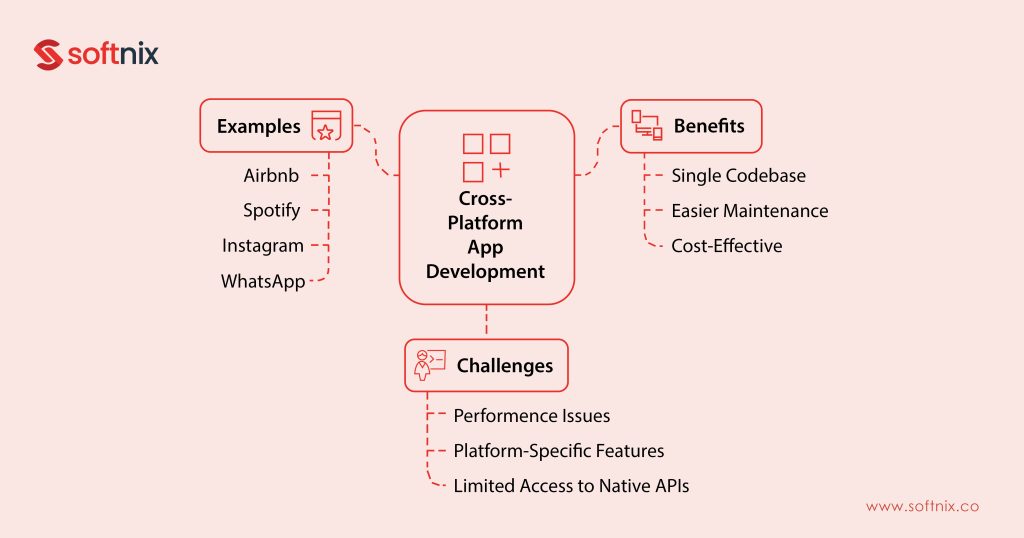
Cross-platform app development enables developers to use a single codebase to create mobile applications that function on multiple operating systems, including iOS and Android.
Instead of writing separate code for each platform, developers can use frameworks like React Native, Flutter, or Xamarin to create a codebase that can be adapted to work across different platforms.
Popular apps like Airbnb, Spotify, Instagram, and WhatsApp are examples of successful cross-platform applications. This approach helps businesses save both time and resources while expanding their reach.
Why Choose Cross-Platform Development for Your Business (Pros)?
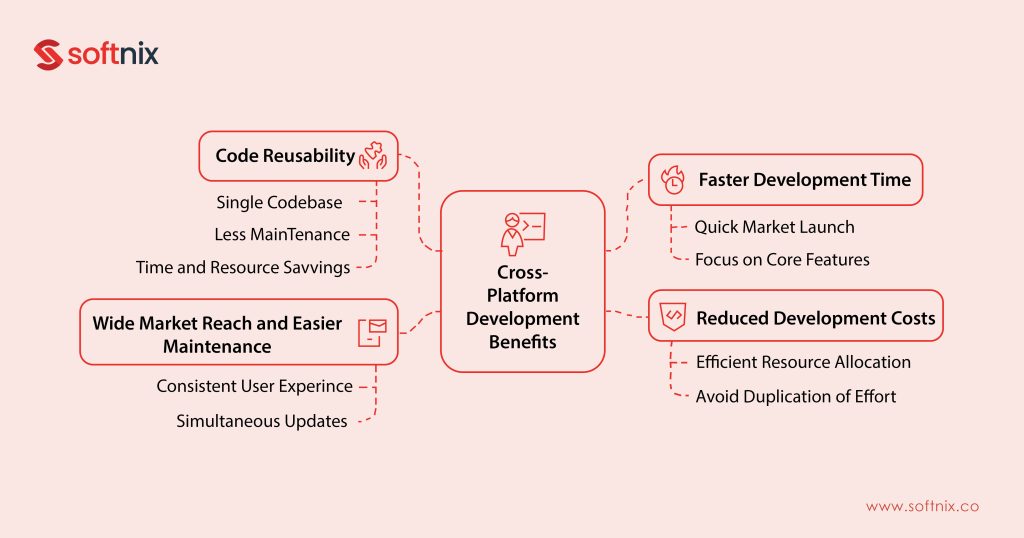
Cross-platform development comes with several advantages, especially for businesses that are aiming to reach a broader audience while keeping costs and development time in check.
1. Code Reusability
One of the biggest advantages of cross-platform development is the ability to reuse code across different platforms. This eliminates the need to create and maintain separate codebases for iOS and Android, thereby simplifying the development process.
For businesses, this means faster development cycles, reduced time to market, and lower maintenance efforts. Code reusability is a key advantage for startups and small companies with limited development resources.
2. Faster Development Time
The shared codebase allows cross-platform development to move at a faster pace than native app development. By focusing on a single codebase for both platforms, developers can concentrate on building core features without having to replicate their work.
This significantly reduces development time, which is particularly useful for businesses aiming to launch their products quickly and start gathering user feedback. For MVPs, this approach can be instrumental in testing the waters and determining whether to invest further in the product.
3. Reduced Development Costs
Building separate native apps for iOS and Android requires distinct development teams and more resources, which drives up costs. In contrast, cross-platform development saves costs by allowing developers to write once and deploy on both platforms.
This can be a substantial cost saver for businesses working with tight budgets. It also helps optimize resource allocation by focusing on a single development cycle.
To understand the full cost structure of creating an app, explore how much does it cost to create an app.
4. Wide Market Reach and Easier Maintenance
By targeting both iOS and Android platforms using a single codebase, cross-platform development allows you to reach a wider audience with less effort.
Updates and maintenance are simplified since any changes made to the app can be applied simultaneously across both platforms, ensuring consistency and minimizing ongoing development costs.
Our Cross-Platform Development
Disadvantages of Cross-Platform App Development
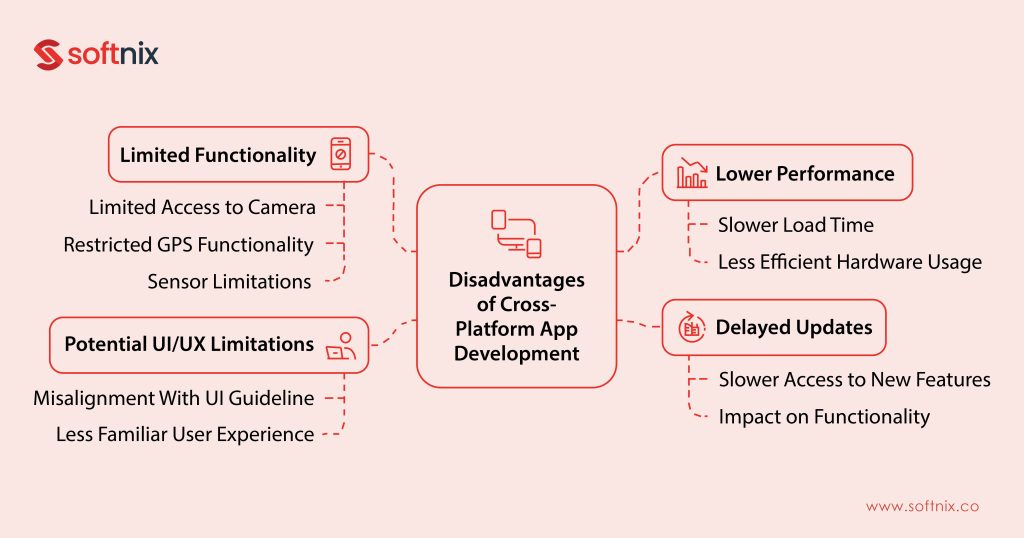
Despite the many advantages of cross-platform development, it’s not the right fit for every app, especially if high performance or advanced platform-specific capabilities are required.
1. Lower Performance Compared to Native
Cross-platform apps often face performance concerns compared to native apps because of the additional abstraction layer provided by the framework.
This can result in slower load times and inefficient hardware usage, particularly in apps that rely on complex animations or require heavy graphic processing, such as games or AR apps.
2. Limited Functionality and Hardware Access
Cross-platform frameworks may not have full access to all platform-specific features or advanced hardware capabilities. For instance, certain hardware components or newer APIs may not be supported, which limits the functionality of your app.
While workarounds such as third-party plugins can help bridge these gaps, they add complexity and may introduce performance bottlenecks.
3. Delayed Updates and Features
Platform providers (iOS and Android) frequently roll out updates, new features, or API changes. It can take time for cross-platform frameworks to catch up with these changes, which can lead to delays in accessing new platform features compared to native development.
This delay could impact the user experience, especially if the updates are significant or if the app heavily relies on platform-specific functionalities.
4. Potential UI/UX Limitations
Cross-platform frameworks may not always fully align with platform-specific UI/UX guidelines. This can lead to inconsistencies that can disrupt the user experience.
Native apps can make full use of platform-specific design elements, while cross-platform apps may struggle to implement these features seamlessly. Users are often accustomed to specific platform behaviors, and any deviation from those expectations can lead to dissatisfaction.
Popular Cross-Platform App Development Tools/Frameworks
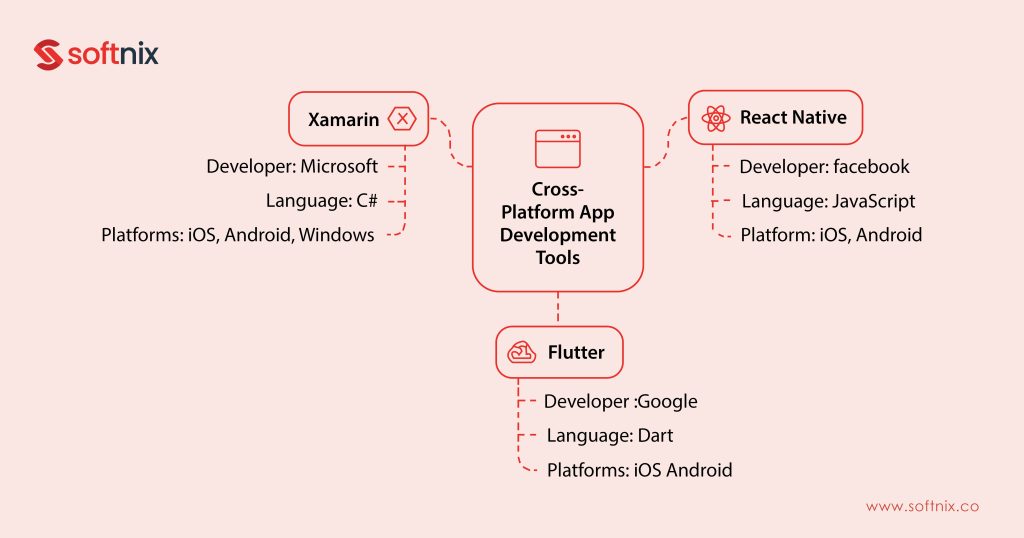
Cross-platform development balances the benefits of native app development and a unified codebase, offering an economical and effective way to reach a larger audience. Developers use several frameworks to build cross-platform apps:
- Xamarin: Developed by Microsoft, Xamarin uses C# and .NET to build native apps for iOS, Android, and Windows.
- React Native: Developed by Facebook, React Native uses JavaScript and React to build native-like apps for iOS and Android.
- Flutter: Developed by Google, Flutter uses Dart to create high-performance, visually attractive cross-platform apps.
These frameworks provide developers with the tools and libraries needed to build cross-platform apps that can deliver a seamless experience across both iOS and Android devices.
Myths Debunked: Cross-Platform vs Native Mobile Development
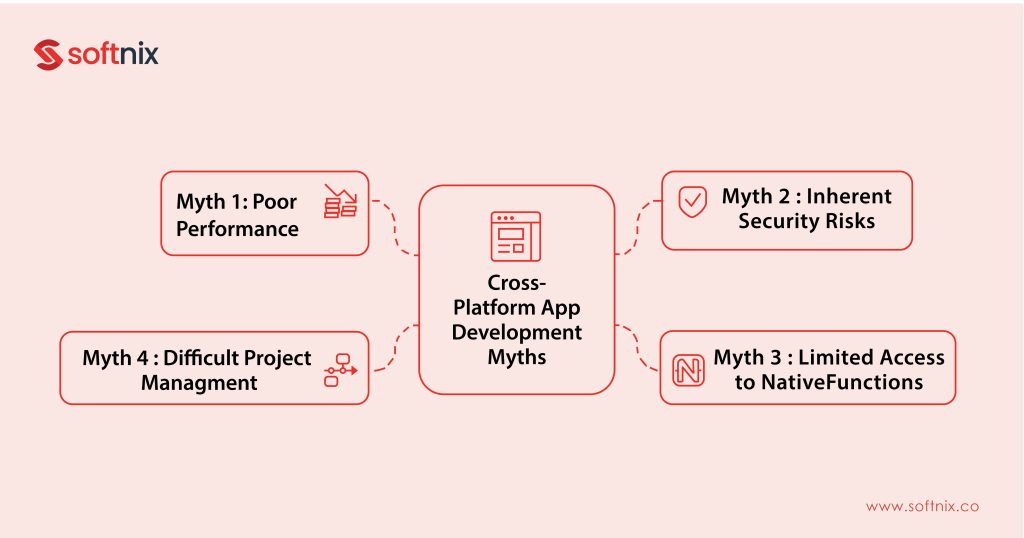
There are many misconceptions about cross-platform and native app development. Let’s debunk some common myths to give you a better understanding of these two approaches.
Myth 1: Cross-Platform Apps Provide Poorer Performance
While native apps may still be faster in certain situations, modern cross-platform frameworks like Flutter and React Native have greatly reduced the speed difference.
Instagram, Skype, and TikTok are examples of high-performing cross-platform applications that prove the potential of cross-platform development.
Myth 2: Cross-Platform Frameworks Are Inherently Unsafe
Security is a major concern regardless of whether an app is native or cross-platform. Cross-platform frameworks are not inherently less secure; their safety depends on implementation quality and adherence to best practices.
Properly encrypted data, secure input validation, and secure coding practices make cross-platform apps as safe as their native counterparts.
Myth 3: Cross-Platform Apps Cannot Access Native Device Functions
Contrary to popular belief, cross-platform frameworks have evolved significantly. With plugins or custom code, cross-platform applications can now access native device functions like cameras, GPS, and push notifications, enabling developers to create robust and feature-rich applications.
Myth 4: Cross-Platform Projects Are Harder to Manage
With the use of advanced cross-platform frameworks and sound project management practices, maintaining and updating cross-platform projects is not necessarily more challenging.
In fact, a single codebase can often streamline maintenance, reduce bugs, and expedite updates compared to managing separate native codebases.
Key Considerations for Choosing Between Native and Cross-Platform Development
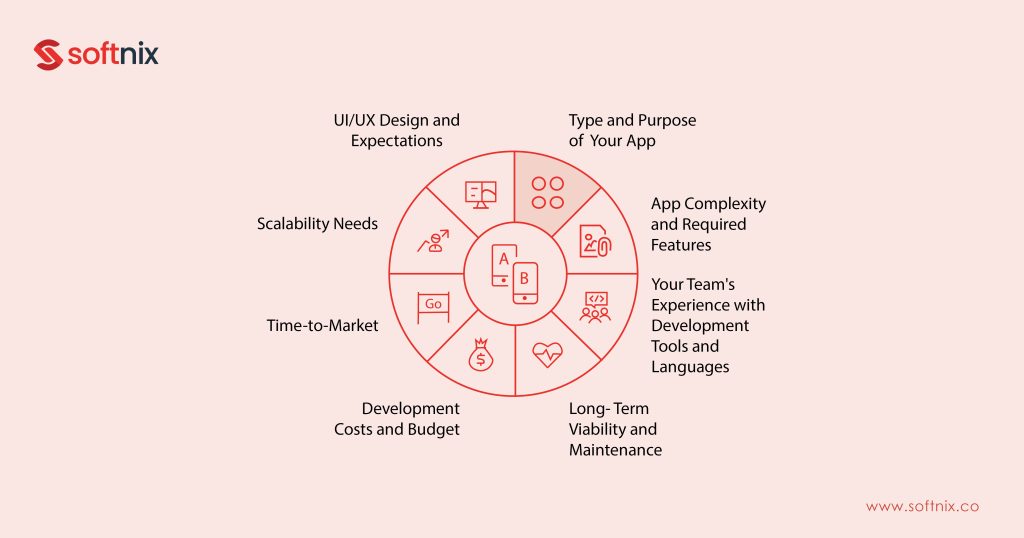
We have discussed the pros and cons of both native and cross-platform software development. Now, let’s look at the elements that should guide your decision when choosing between these two strategies.
Type and Purpose of Your App
The purpose of your app should be a key factor in deciding between native and cross-platform development. For performance-critical apps like gaming, real-time interaction, or AR/VR, native programming is generally preferred because it provides direct access to platform hardware and optimized APIs.
On the other hand, cross-platform development can be a more affordable choice for simpler apps that share similar features across platforms, like e-commerce apps or internal tools.
App Complexity and Required Features
The choice of development approach is also influenced by the complexity of your application. Applications with complex animations, advanced features, or high hardware consumption benefit from native development.
Cross-platform frameworks are more suited for simpler applications where functionality is mostly uniform across platforms, such as basic utilities or content delivery apps.
Your Team’s Experience with Development Tools and Languages
Your development team’s expertise is another factor worth considering. Teams experienced in Swift or Kotlin may find native development more straightforward and efficient, as they can use their knowledge to optimize for specific platforms.
On the other hand, teams proficient in C#, JavaScript, or Dart can find success in cross-platform development with tools like Xamarin or Flutter.
Long-Term Viability and Maintenance
Consider the long-term scalability and ease of maintenance when deciding between native and cross-platform development. Managing several native codebases is more time-consuming and complex compared to maintaining a single cross-platform codebase.
Cross-platform apps can be easier to maintain, with updates applied consistently across platforms.
Development Costs and Budget
Development costs can vary significantly between the two approaches. Native development often involves higher initial costs, as separate apps are required for each platform. This means you need distinct development teams skilled in each platform’s language and tools.
Cross-platform development offers cost efficiencies by using a shared codebase, which can help cut down on development and maintenance expenses. This makes it an attractive option for startups or small businesses looking to optimize costs without compromising on market reach.
Companies should consider their budget limitations when choosing the right approach for their project. If the budget allows, investing in native apps may be worthwhile for superior user experience and performance. On the other hand, cross-platform development makes sense for reducing overall expenses.
Time-to-Market
For businesses needing to launch their app quickly, time-to-market is a critical consideration. Cross-platform development speeds up the launch process, as a single codebase is used to deploy apps on both platforms simultaneously.
This faster development cycle makes cross-platform an excellent choice for companies under tight deadlines or those wanting to test an MVP. By quickly launching the product, businesses can gather valuable user feedback and iterate based on real-world usage.
In contrast, developing native apps for iOS and Android can take longer due to the need for separate development and testing. However, the result is often a more polished and reliable app, which may make the extra time investment worthwhile for certain business types.
Scalability Needs
If you envision your app growing significantly in terms of user base or feature set, scalability is key. Native development offers more flexibility for adding advanced features and ensuring high performance as your app scales.
For businesses that are in for the long haul and plan to add complex features, native apps can provide the infrastructure needed to handle more users efficiently. Features like advanced graphics, AR/VR capabilities, and real-time processing work better when directly integrated into platform-specific capabilities.
Cross-platform apps can also be scaled, but they may face limitations when dealing with high-performance or resource-intensive features. If your app’s main objective is user engagement, cross-platform scalability is sufficient. However, for significant growth and intricate functions, native development may be more suitable.
UI/UX Design and Expectations
The type of user experience you aim to deliver should also influence your choice. Native apps provide a more refined, responsive user experience because they follow platform-specific guidelines and use device hardware optimally.
For instance, iOS and Android users have different expectations regarding navigational elements and visual designs. Native apps are better positioned to meet these expectations and can leverage platform-specific nuances, such as gestures and smooth animations, which significantly enhance the user experience.
Cross-platform frameworks have made significant advances in providing near-native experiences, but certain intricate design elements or platform-specific interactions are still better achieved with native development. If a premium user experience is your priority, native development is generally the way to go.
Native App Development vs Cross-Platform App Development: Comparison Table
| Feature | Native App Development | Cross-Platform App Development |
| Performance | Offers the highest performance as it leverages platform-specific hardware and APIs. Ideal for games, AR, and graphics-heavy apps. | Performance may vary depending on the complexity of the app. Generally suitable for non-intensive apps. |
| User Experience | Native apps offer a UI/UX that aligns perfectly with the platform’s design guidelines, giving a seamless experience to users. | Can provide a near-native experience but might lack nuances like animations and smooth transitions. |
| Code Maintenance | Requires maintaining separate codebases for each platform, which can increase complexity and maintenance costs. | Single codebase simplifies maintenance, making updates and fixes easier to implement across all platforms. |
| Development Cost | Higher cost due to different teams needed for iOS and Android development. | Lower initial cost as developers work with a single codebase to target multiple platforms. |
| Feature Integration | Complete and easy integration of platform-specific features, including camera, GPS, and biometric authentication. | Limited access to some platform-specific features; often requires additional plugins or custom code for full functionality. |
| Security | Provides superior security by using platform-specific security features like encryption, biometric authentication, and secure storage. | Can be made secure, but often relies on third-party plugins, which can introduce vulnerabilities if not managed properly. |
| Suitability | Best for companies aiming for high-quality performance, superior UX, and deep integration with platform features. | Suitable for startups, MVPs, and businesses looking to develop an app quickly and cost-effectively. |
Cross-Platform vs Native Mobile Development for Enterprises: Key Use Cases
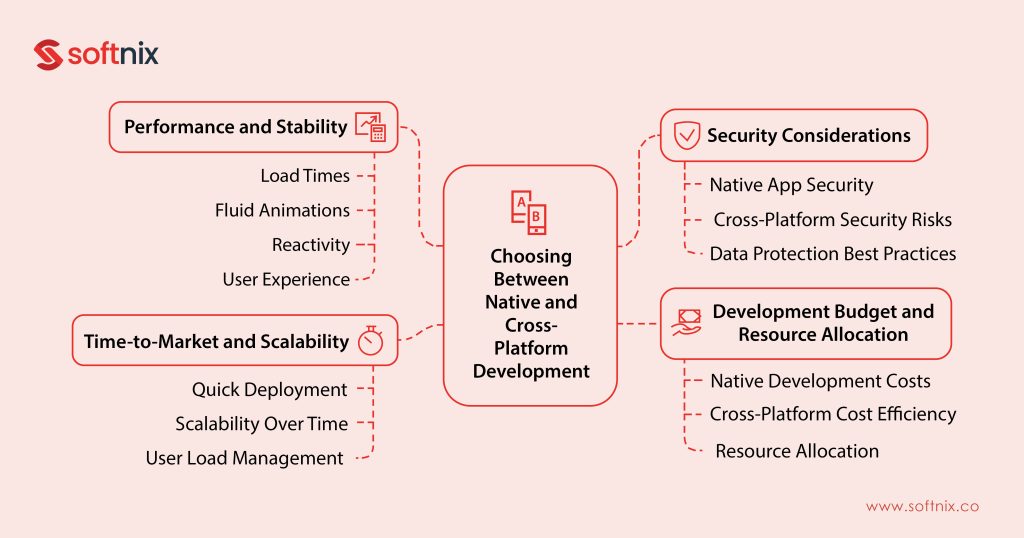
When to Choose Native Development
- Gaming Applications: High-performance requirements make native the go-to option for gaming apps that rely heavily on the device’s GPU and real-time rendering.
- AR/VR Experiences: Augmented Reality (AR) and Virtual Reality (VR) require sophisticated interaction with the hardware, which is best achieved with native development.
- Healthcare or Financial Apps: These apps require robust security measures to safeguard sensitive information and user privacy, which native tools provide more effectively.
When Cross-Platform Development Fits the Bill
- Startups with Limited Budgets: If you need to launch an app without breaking the bank, cross-platform frameworks like React Native and Flutter provide a cost-effective solution.
- MVPs (Minimum Viable Products): Testing the market quickly with an MVP to validate your idea is much more feasible using cross-platform solutions, as you can launch across iOS and Android in less time and at a lower cost.
- Content Delivery and E-Commerce: Apps that are mainly used to deliver content or facilitate e-commerce transactions—where the features across platforms are more standardized—are well-suited to cross-platform development.
Making the Right Choice for Your Enterprise
Selecting the right development approach can have a lasting impact on your app’s success. Let’s take a look at the decision points you should consider when making this choice:
- Performance Standards: Determine if your app requires flawless performance, low latency, and quick response times. If so, native development is the best option.
- Security Requirements: Do you handle sensitive user data or have specific compliance requirements? If yes, native development is advisable, especially for regulated industries.
- Development Budget: Evaluate your budget limitations. Cross-platform development is typically less expensive, both initially and in the long term, which can be an advantage for companies operating with financial constraints.
- Launch Timeline: If you need your app launched quickly or have strict deadlines, a cross-platform approach will help you meet your goals.
- Growth and Expansion Plans: If you expect your app to grow rapidly, it’s important to consider scalability. Native apps are more flexible and efficient for incorporating complex features and scaling to meet increasing demands.
- User Experience Goals: How crucial is the user experience to your app’s success? If creating a polished, responsive, and immersive experience is vital, then native development is the ideal path forward.
Final Thoughts
When deciding between native and cross-platform app development, it’s essential to consider the scope and goals of your project. Native apps offer superior performance, deeper hardware integration, and a better user experience, but they also involve higher costs and longer development times.
On the other hand, cross-platform development is faster and more economical, making it an ideal choice for startups and companies with limited budgets or those needing to launch quickly.
At Softnix, we have a team of skilled developers ready to assist you in creating a high-quality mobile application, whether you choose native or cross-platform development. Our goal is to ensure that your application not only meets your business needs but also delivers an excellent user experience.
Reach out today to discuss your project, and let our expertise guide you toward building a successful and impactful app for your business.
FAQs
1: How can cross-platform mobile development help my startup save time and money?
Cross-platform development allows you to create a single codebase that runs on both iOS and Android. This saves time and development costs by avoiding the need to manage two separate codebases. As a result, you can reduce maintenance expenses and speed up updates, leading to an overall reduction in costs.
2: Will a cross-platform app provide the same performance as a custom-built native one?
Cross-platform apps generally work well for most tasks but may fall short when performing resource-intensive activities. Native apps are better suited for applications requiring high computational power, such as gaming or real-time processing, due to their seamless integration with the device hardware.
3: Do I need different technologies to build apps for iPhone and Android?
Yes, native apps require distinct technologies—such as Kotlin or Java for Android and Swift or Objective-C for iOS. However, using cross-platform tools like React Native or Flutter allows developers to create applications for both platforms using a single codebase.
4: Are apps built for multiple platforms still secure for my customers and business?
Yes, cross-platform apps can be secure, but developers need to adhere to best practices for security and data protection. Ensuring all plugins are vetted and tested thoroughly helps maintain a secure environment for both user and business data.
5: How does app store approval differ for native vs cross-platform apps?
The app store approval process is largely the same for both native and cross-platform apps. Both must meet the specific requirements of their respective app stores (iOS or Android). However, cross-platform apps may face extra scrutiny if they do not integrate seamlessly with native functionality.
6: How can I reduce the cost of building my app without sacrificing quality?
Consider cross-platform development to reduce costs while maintaining quality. By using a single codebase for both platforms, you avoid developing two separate apps, thus saving on both development and maintenance. Utilizing pre-existing frameworks or open-source libraries can also help reduce costs.
7: Is cross-platform development suitable for all types of mobile applications?
Cross-platform development works well for content-driven or straightforward apps. However, for applications needing advanced hardware integration, superior performance, or unique platform-specific features, native development is usually the preferred approach.
8: Can native apps be easily converted to cross-platform apps?
Converting native apps to cross-platform can be challenging. Typically, the process involves significant refactoring to ensure compatibility with cross-platform frameworks, which may include rewriting parts of the codebase. Depending on your app’s architecture, the conversion can be complex and costly.

